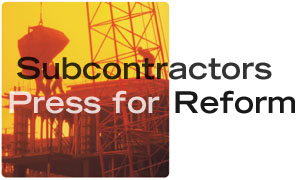
Retainage is the practice applied by general contractors of holding back a specified portion of a subcontractor’s payment until it has been determined that the job is complete and is acceptable. However, subcontractors say it often withholds their money for an extended period of time and can cause cash flow problems for them.
According to David Mendes, director of communications for the American Subcontractors Association (ASA), few subcontractors feel that retainage is what pushes them to finish a job and to get it right. “Four out of five say that retainage is not a motivating factor,” stated Mendes. Perform-ance bonds, he noted, are a more effective means of ensuring proper completion of a subcontract.
Subcontractors may carry as much as “hundreds of thousands of dollars in retainage as receivables, and wait on average more than five months” for that final payment, Mendes said. With so much money tied up, a subcontractor may not be able to take on new projects and/or may have to borrow to make up for the delayed capital.
An Antiquated Practice
The ASA’s position is that “Retainage is an antiquated practice that needs to be abolished.” Because of this, the association has been pressing for retainage reform legislation in various states. Mendes says that the campaign has crystallized in recent months, with several states enacting limitations on retainage and others close to doing so.Four states, he said, have enacted major reform legislation: California, Maryland, Montana, and New Mexico. “ASA chapters played a pivotal role in each case,” he remarked. Chapters in Missouri are now putting their weight behind a reform bill in that state.
In California, Governor Gray Davis (D) signed two bills permitting design-build methods in transit operations (A.B. 958) and multi-county projects (A.B. 2296). “ASA of California supported these bills, which contain retainage pass-through provisions and bid listing of subcontractors,” said Mendes.
However, another bill (A.B. 424) which would have allowed construction of schools through design-build methods, was vetoed by the governor because it specified a maximum retainage level of 5%. Unlike the proposed school legislation, Mendes commented, “the bills that were signed by the governor did not specify a maximum percentage of retainage, but instead limited it by stipulating that the general contractor cannot retain a greater percentage of funds from the subcontractor than the owner retains from the general contractor.”

No Exemption
ASA of Baltimore and the DC Metropolitan Subcontractors Association extended an earlier victory in Maryland. The chapters followed up on their success in the 2000 legislative session on a bill capping retainage at 5% on contracts for most of the state of Maryland’s public works. “How-ever, University of Maryland projects were exempt until the chapters convinced legislators to enact a bill removing the university system’s exemption,” he said.ASA of Montana helped bring about enactment of S.B. 298. “Governor Judy Martz (R) signed the law on April 23, making the maximum amount that can be retained from subcontractors equal to the percentage retained by owners from general contractors,” Mendes related. “The bill also limits the amount that an owner can retain from a general contractor to 10% in private contracts.”
On March 16, New Mexico Governor Gary Johnson (R) signed the Retainage Act (H.B. 320) fought for by ASA of New Mexico. “The law reforms retainage, including requiring escrow accounts that pay interest, and setting a percentage limit on the amount that owners can retain from contractors,” said Mendes. “The new law, which applies to public and private work, also includes prompt-pay provisions.”
The Missouri Senate Labor and Industrial Relations Committee approved H.B. 662 and sent it to the senate floor for a full vote. “This bill would limit the amount that an owner could retain from a general contractor to 5% in private contracts, require funds to be held in trust for contractors, and allow contractors to substitute securities in place of retainage,” he said.
The retainage reform campaign will continue, Mendes affirmed. Judging by the trend, he expects it to extend into other states where reform is needed.
For more information, contact Mendes at 703-684-3450, ext. 335; dmendes@asa-hq.com (e-mail); or visit the ASA website at www.asaonline.com (website).
Publication date: 08/20/2001

